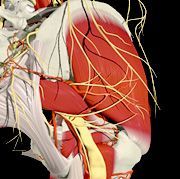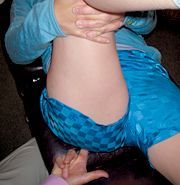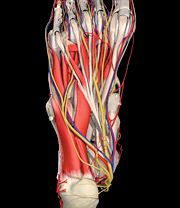Recent laws in New Jersey and California represent a disturbing trend that will negatively impact a practice’s ability to collect monies from patients, as well as expose them to significant penalties if the practice does not follow the mandatory guidelines to a T. Please be aware that a similar law may be coming to your state. The time to act is before the law is passed.
Manual Therapy for the Sciatic Nerve
How can we affect the nerves directly? Do the nerves and their fascial layers develop restrictions similar to that of other connective tissues? Can we release these restrictions with manual methods? Jean-Pierre Barral, a French osteopath, would answer yes to these questions.
My two previous articles, "Understanding and Diagnosis of Nerve-Related Pain" and "Correcting Sciatic Nerve Tension," reviewed diagnosis- and movement-oriented treatment of sciatic neuritis.1,2 This article will describe manual methods and variations on myofascial release applied to the nerves and their sheaths, focusing on Barral's model.
Barral (of visceral manipulation fame) and his co-author, Alain Croibier, developed techniques aiming at releasing restrictions in the peripheral nerves. They recently published a well-designed text, Manual Therapy for the Peripheral Nerves.3 Unfortunately, Barral's references are dated. In my opinion, the technique itself is brilliant, but the neurophysiological understanding of the work is limited. Don Hazen, a chiropractor and Rolfer, has written extensively about Barral's neural-mobilization model. Hazen has studied the newer neurology models and tried to describe the physiological basis of this work more accurately. I appreciate that Hazen's Web site shares his writing freely. I am including a link to his paper on what he calls "The Neurology of Posture."4

As with many of the procedures we use, we really don't know exactly how or why they work. Geoffrey Bove, DC, PhD, wrote to me. He said, "There is no evidence that nerves demonstrate altered mechanics when they are painful. In fact, there is a lot of evidence from human studies using ultrasound imaging (see Dilley and Greening) that proves that even in pathological conditions like carpal tunnel, thoracic outlet, etc., there is normal nerve movement. It does not mean the methods do not work - not at all. It means there probably is a different mechanism, that's all. I suspect the mechanism lies in the reduction of inflammation by some interventive means. I think the methods, if and/or when they work, work by moving the nerves and mobilizing the inflammatory milieu, which then is resorbed."
Manual release techniques for the peripheral nerves are deceptively simple. Find the restricted nerves and release them with either gentle traction or in a transverse, across-the-nerve manner. Barral often adds passive movement of the involved limb as he does his manual methods on the nerves themselves. I say deceptively simple, as Barral's work in visceral manipulation and peripheral-nerve mobilization always demands gentleness, precision and well-developed palpation and "listening" skills.
You are not doing deep tissue to the nerves. This gentle touch is a challenge for chiropractors. Typically, we use more vigorous manual adjusting and trigger-point therapies. Harsh pressure to an inflamed nerve usually will create more irritation. When the nerves are the key tissue and you effectively release them, you'll often feel the joint restrictions at that level immediately release. The muscle tightness in the area also will soften dramatically.
Here is a short description of how to release the upper part of the sciatic nerve, just inferior to where the nerve exits from under the sacrum. (This technique is pictured in the figures that accompany this article.) If the patient has right-sided sciatica, sit on the right side of the patient, facing them. Reach under the buttock with your right hand. Start palpating the space between the greater trochanter and the ischial tuberosity. About halfway between these two bones, if the sciatic nerve is irritated, you'll feel a vertical tubular structure, which is the nerve itself. It's fairly big here; it will feel like it's the size of a little finger. Place your index or second finger on the nerve itself. You are not across it. Instead, your finger is parallel, lined up with the nerve, obliquely sagittal.

Here is where soft touch is critical. Use a gentle pressure on the nerve, just enough to engage it. Then, gently traction the nerve in an inferior direction. At the same time, the patient will be lengthening the nerve. Have the patient bring their right thigh up to a flexed position, with the lower leg also flexed (90/90). Have the patient slowly extend the lower leg until they feel a pull in their nerve or hamstrings. As they extend the leg, you are further lengthening and releasing the nerve. They should do three to six repetitions of this motion as you gently release the nerve. You should feel a softening under your finger. I've posted a YouTube video showing how I use manual therapy for the sciatic nerve.5
This is not exactly Barral's technique. I have modified his method using Butler's nerve-tensioning principles together with Barral's manual therapy. You can use the same basic technique, going further superior to just below the sacrum and inferior down the leg. You must be able to feel the nerve itself. Key areas to check include the tibial nerve, both above and below the knee where the muscles split and you easily can get to the tibial nerve, directly in the middle of the leg. Another significant area is the medial plantar nerve, on the medial side of the bottom of the foot. This is not plantar fasciitis; the nerve itself is almost always tender in sciatic irritation.
I'd like to share a recent case that reminded me of how important this work can be. A.D. is an 80-year-old woman. She had been suffering from sciatic nerve pain down her entire right leg for more than four years. Her pain was severe and was the "center of her life." Despite her good attitude, she lived in the "mask of pain." She tried decompressive surgery a few years ago, which gave her temporary relief, but the pain returned. She had received several transforaminal epidurals with minimal benefit. She had a long course of PT, again to no avail. She was frustrated that virtually everything she did irritated her leg. She initially was seen by my partner, who used various distraction and other low-force manipulation techniques without success. He referred her to me as a last resort.
She clearly had severe allodynia, extreme sensitivity to normal touch, especially over the pathways of the right sciatic nerve and virtually all of its branches. It's always a challenge to use touch to help a patient who can barely tolerate being touched.

We started with two basic approaches. The first involved finding some simple, basic nerve-mobilization exercises that did not hurt or irritate her. The second was using Barral's model to release the nerves. Her key areas of nerve restriction were the sciatic nerve at the sciatic notch, the common peroneal nerve and its superficial peroneal nerve branch, and the medial plantar nerve in the foot. Barral and Croibier talk about how significant the more distal nerves, such as the medial plantar nerve, can be.3
Barral and Hazen talk about the fact that nerves usually are not very palpable, and are soft and yielding.3,4 When the nerves are irritated, the "feel" of the nerves changed dramatically. They feel like hard tubes. Once you have felt a few of these, your fingers will understand this. A.D.'s nerves, all the way down her leg, had this hard feel and extreme super-sensitivity.
I had to back way off on my pressure, which always is a good idea when directly treating the nerve. I used a light pressure, which did cause her pain, but was barely tolerable. I could feel the nerves begin to release under my hands.
This was not a simple case. She did have, after our third treatment, what I call an "end-of-the-tunnel" experience, meaning she had a good day, a day with minimal pain, which felt huge to her. We continued for several weeks and added in laser treatment, electrical stimulation and bodywork from a massage therapist trained in Aston patterning.
By the end of six weeks, she basically was pain free. In my mind, this one case would be enough to make me appreciate Barral's nerve techniques. One life, one person's health, dramatically altered in the right direction. An 80-year-old suddenly given a new lease on life. I am always grateful to participate in both the small victories and the miracles we see in our practices. I recognize there is no good research or peer-reviewed published material on these techniques. I am going beyond the evidence, hopefully using common sense, using good evaluation methods and staying "down to earth."
Barral's nerve mobilization techniques, as outlined in his text, are exhaustive. He has gone through the peripheral nervous system, describing and picturing techniques for almost all of the peripheral nerves.3 If this work interests you, I suggest you get his book.
My past three articles have focused on nerve pain, using the sciatic nerve as the example. I'll briefly summarize. First, nerves can get sensitized and irritated, and stay that way. The practitioner needs to both understand facilitated nerves and to be able to explain this to the patient. We have useful tools both for measuring and improving these nerve pains. Butler has developed sophisticated low-tech evaluation tools based on simple variations of physical examination of the nerves. There are a variety of ways to help the nerves become less irritated. These include McKenzie extension exercises and Butler's nerve-gliding and nerve-tensioning exercises.
You also can more directly treat the nerves. Directly over the sciatic nerve, you could use Barral's low-force manual therapies. You would want to check all of the branches of the sciatic nerve; even those farther away from the obvious symptoms could be significant.
Additional tools I haven't addressed fully in this series include approaches that focus on the dura, such as craniosacral methods. Don't forget the container, myofascial and joint restrictions clearly affect the nerves. Assess and correct involved joints, including the sacrum, the sacroiliac joints and the lumbar facet joints. If there is midline lumbar interspinous or spinous process tenderness, incorporate decompression both in the office and as at-home exercises. Teaching basic core stability also is essential.
Acute severe discogenic sciatica is an easily diagnosed condition. Chronic, low-grade sciatic-nerve irritation is common and frequently missed in diagnosis. It can present with leg, hip and/or low back pain. Look for this type of sciatica, address it and you'll help more patients.
References
- Heller M. "Understanding and Diagnosis of Nerve-Related Pain." Dynamic Chiropractic, March 25, 2008. www.chiroweb.com/archives/26/07/12.html.
- Heller M. "Correcting Sciatic Nerve Tension." Dynamic Chiropractic, May 6, 2008. www.chiroweb.com/archives/26/10/13.html.
- Barral J-P, Croibier A. Manual Therapy for the Peripheral Nerves. New York: Churchill Livingston, 2007.
- Hazen D. "The Neurology of Posture." www.dhazen.com/neuropages/nerv_struct.html.
- www.youtube.com/results?search_query= marchellerdc&search_type=.


